In Drying Colorado River Basin, Indian Tribes Are Water Dealmakers
Native Americans hold 20 percent of the basin’s water rights. How they use their water will shape the future of the Southwest.
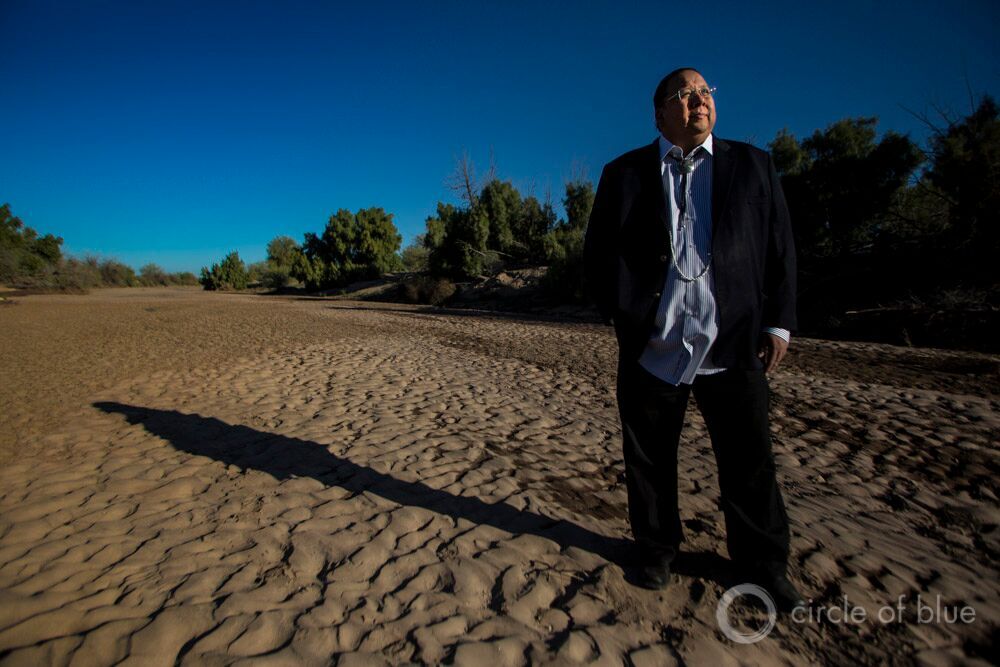
Governor Stephen Roe Lewis, leader of the Gila River Indian Community, stands in the dry bed of the Gila River, outside of Sacaton, Arizona. Elected last year, Lewis proclaimed 2015 the Year of Our Water Rights for his tribe. © J. Carl Ganter / Circle of Blue
By Brett Walton, Circle of Blue
Mired in drought and torched by one of the hottest years ever measured, the seven states of the Colorado River Basin are acutely aware of how a desert can bully water supplies. They are not alone. In this cauldron of collaboration and competing interests is a collection of players who are just as significant for managing and responding to water scarcity but attract much less attention: the basin’s 29 federally recognized Indian tribes.
With the oldest claims to water, the tribes command a considerable role in directing the region’s future. Combined, they hold rights to a substantial portion of the Colorado River’s flow: roughly 20 percent, or 2.9 million acre-feet, which is more water than Arizona’s allocation from the river. The tribal share, moreover, will increase, perhaps by as much as hundreds of thousands of acre-feet as the 13 tribes without confirmed rights settle their claims with federal and state governments.
“The tribes are the huge unknown.”
–Robert Glennon, law professor
University of Arizona
Years of careful negotiations, spurred by a desire to avoid long-running court battles, produced legal settlements that provide water for tribes, cities, and industries. Beneficial to all sides, the settlements were a catalyst for urban development and a tool for funding Indian water systems. Perhaps more importantly, the settlements are the foundation of a partnership, an inescapable union, between tribes and their neighbors, a union that will grow in importance as water becomes scarcer in the warming and drying American West.
“We’ve developed tremendous and valuable relationships with each other from being in the same room for years,” Kathryn Sorensen, director of the Phoenix water department, told Circle of Blue. “Water is always important and contentious in Arizona. But having relationships helps you have conversations when you want new solutions.”
“Solutions” is the word of the moment in the Colorado River Basin, and for good reason. California is suffering a drought emergency that reveals the paramount significance to Southern California of water diverted from the Colorado. Last week, water levels in Lake Mead, formed from the Colorado and the nation’s largest reservoir, dropped below 1,075 feet in elevation, the threshold for declaring the basin’s first mandatory water cuts if such low levels persist to January, the benchmark month for such a declaration.
Attempting to delay the day of reckoning, the seven basin states announced last year a sheaf of proposals to conserve water and store the savings in Lake Mead. In the long run, river flows could decrease by 9 percent by 2060 because of climate change, according to a 2012 federal government study. The realization of water limits has come swiftly and forcefully.
The Colorado River is fully allocated, which means all the water is claimed. Some cities and farm districts feared that tribal water settlements would create conflict by taking water away from current users. Those worries have not, to this point, materialized. In pursuit of their water rights, the tribes have been the basin’s dealmakers. They sold rights for money to build systems that will deliver water to reservation faucets. They leased water to cities, to bring in additional funds for tribal development. They participate in programs that store water underground, to bolster depleted aquifers, and leave water in rivers, to benefit ecosystems.
But beneath the current amity, there is still concern. Tribes do plan to use more water once they have the money to build out irrigation systems and develop commercial enterprises. A group of the largest tribes persuaded the Bureau of Reclamation to study the effects on the Colorado River Basin as more tribal rights are exercised. Reclamation, the federal agency that manages the basin’s largest dams, calls tribal water use a “critical uncertainty.”
How tribal water use evolves in the decades to come — and the time scale is that long — is perhaps the biggest question mark on the demand side of the Colorado River’s water availability equation.
“The tribes are the huge unknown,” Robert Glennon, University of Arizona law professor, told Circle of Blue. “This is a huge issue.”
Adding Flexibility to the System
The tribes of the Colorado River Basin are a diverse group. The Navajo Nation, the largest, straddles three states and has claims to water from multiple tributaries. The land of the Colorado River Indian Tribes lies in the river’s floodplain in Arizona and California and covers large tracts of irrigated agriculture. The Southern Utes, located in the Colorado quadrant of the Four Corners region, are known for fossil fuel development.
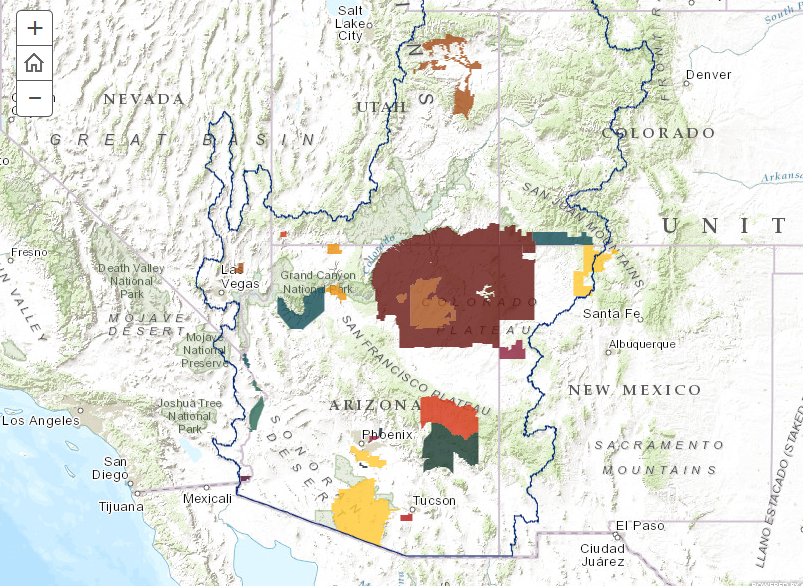
This map shows the 29 federally recognized tribes in the Colorado River Basin. Map © Kaye LaFond / Circle of Blue
Accordingly, each tribe’s goals for its water rights are unique, said Doug Kenney, a University of Colorado law professor who studies the basin.
“I’m a believer that there is a great opportunity for the tribes to be a part of the basin’s solutions,” Kenney told Circle of Blue. “Historically the water community has feared the day when tribes put water to use. The way I look at it, a lot of tribes are interested in doing creative arrangements.”
Creative, Kenney said, means getting an economic benefit without taking water out of the river — using water, for example, to propel a nascent tourism industry by ensuring sufficient stream flows for rafting or fishing. Creative also means selling the temporary right to use water to others, an action called leasing, which is common in the Phoenix metro area. Home to 4.5 million people, Phoenix and its Sonoran Desert neighbors are the biggest beneficiaries of these creative arrangements.
Phoenix leases water from three tribes, and a fourth agreement is nearing completion. The terms of the deals are straightforward. Phoenix makes an upfront payment, typically millions of dollars, to the tribe and pays an annual charge to cover the cost of pumping the water to operators of the Central Arizona Project (CAP) canal, which transports Colorado River water hundreds of miles to the dry heart of the state. (See sidebar for a list of leases and payments.)
Most of Phoenix’s leases run for 100 years. Together, they provide roughly 3 percent of the city’s surface water supply. The importance of the leases is much larger than that fraction, according to Sorensen, head of the water department. Leases allow Phoenix to conserve its groundwater reserves for drought emergencies and urban growth, she said.
Phoenix, Glendale, Scottsdale, and dozens of other cities in Maricopa and Pinal counties grew rapidly three decades ago with Colorado River water shipped through the Central Arizona Project. With imported water supplementing the Gila, Salt, and Verde rivers and relieving pressure on depleted groundwater reserves, a modern oasis society expanded. The region’s population is double what it was in 1990.
Leasing is a popular practice. In 2015, roughly 8 percent of the CAP deliveries were water leased from tribes. In Arizona, however, leasing is restricted by legal decree to the tribes that receive CAP water. The tribes on the Colorado River mainstem cannot rent out their water, a prohibition that some tribes would like to overturn. “Tribes are emerging participants and leaders for water management in central Arizona,” Chuck Cullom, Colorado River manager for CAP, told Circle of Blue.
How Much Water Will the Tribes Use?
Still, water managers and other Colorado River users worry that water supplies will diminish as tribes expand irrigation or develop water-consuming businesses on their reservations. The concerns are heightened by the reticence among tribal leaders to publicly disclose their plans.
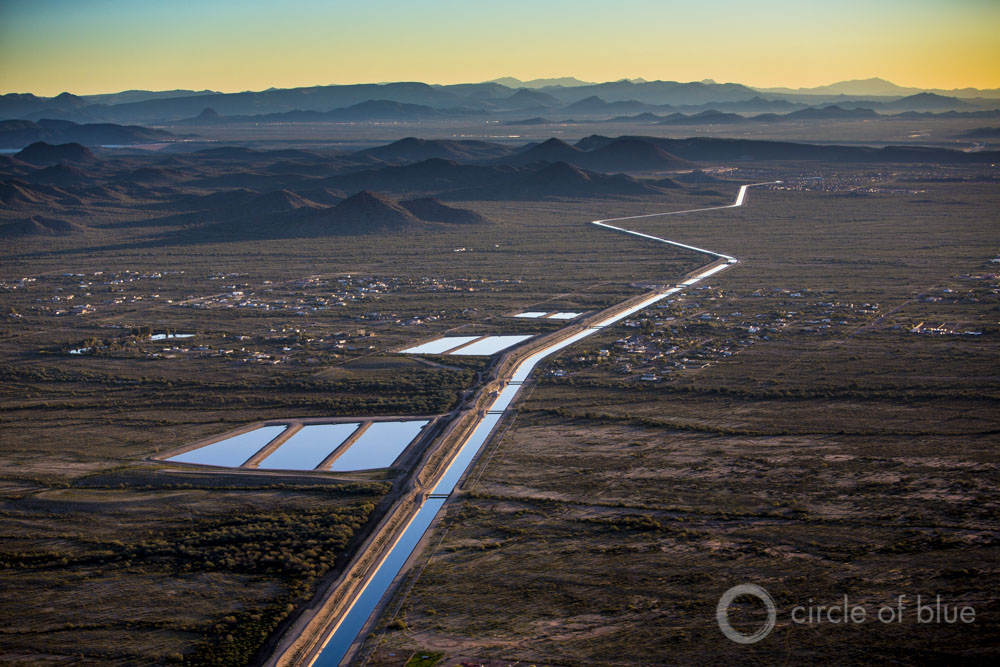
The Central Arizona Project canal passes groundwater recharge ponds to the north of Scottsdale. The 540-kilometer (336-mile) canal delivers Colorado River water to cities, farms, and tribes in the interior of Arizona. Photo © J. Carl Ganter / Circle of Blue
In one of the rare public presentations, Darryl Vigil, chairman of the Ten Tribes Partnership, a group of tribes holding the largest water rights in the basin, testified at a U.S. Senate Energy and Natural Resources subcommittee hearing on July 16, 2013. Vigil explained that the tribes expect the federal government to exercise its responsibility to protect tribal rights from water users with more influence.
“The Ten Tribes are very concerned that while they struggle to put their water to use, others with far more political clout are relying on unused tribal water supplies and will seek to curtail future tribal water use to protect their own uses,” Vigil told the committee.
In response, the Bureau of Reclamation is undertaking an assessment of tribal water use. Due in mid-2016, the study will analyze the effects on farms, cities, and industries in the basin as the tribes seek to expand irrigated agriculture, develop commercial enterprises, or otherwise increase water use.
Circle of Blue attempted to contact Vigil for several months for an interview, but he did not return phone or email messages. Few tribes, for that matter, were willing to discuss their water plans. Circle of Blue sought interviews with leaders of seven tribes in the basin — Gila River Indian Community, Navajo Nation, Jicarilla Apache Nation, Colorado River Indian Tribes, Fort McDowell Yavapai Nation, Salt River-Pima Maricopa Indian Community, and San Carlos Apache Tribe.
The governor of the Gila River Indian Community, who declared 2015 the Year of Our Water Rights for his tribe, agreed to an interview but canceled at the last minute and did not reschedule. Carole Klopatek, who represents the Fort McDowell Yavapai, told Circle of Blue, “We keep our water right plans confidential within the council and do not speak with the press.”
Only the San Carlos Apache spoke with Circle of Blue.
Except for a mining company that wants to open a copper mine near the reservation, the San Carlos Apache have good relationships with its non-tribal neighbors, according to Tao Ettison, the tribe’s vice chairman.
Half of the tribe’s water rights are used on the reservation and half are leased, Ettison explained. The tribe is looking for new uses for its rights, namely through farming.
“We have several sites identified for irrigation expansion,” Ettison told Circle of Blue. “We’re progressively working at it every day.”
Settlements, Not Litigation
A tribe’s right to water is derived from the U.S. Supreme Court’s seminal Winters decision, in 1908. In Winters, the judges ruled that the creation of an Indian reservation by the U.S. government carried with it an implied right to water. Known as federal reserved rights, each tribe’s claims dated to the year the reservation was established. In western water law, which is generally based on a doctrine of first-come, first-served, the Winters decision put the tribes at the head of the line for water — before the miners, farmers, and cities that sprouted in the West after the native lands were forcibly cleared.
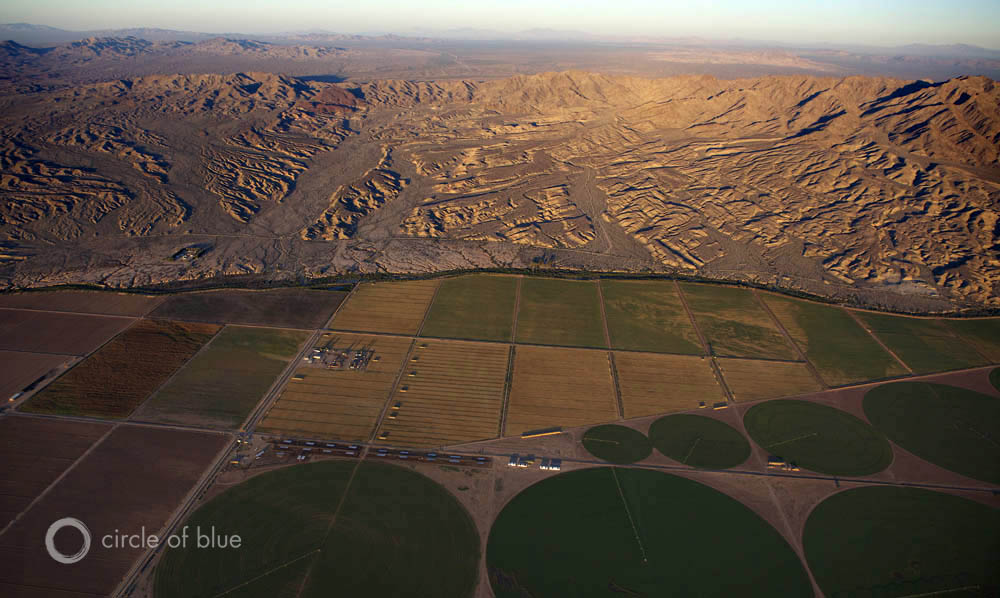
Irrigated fields border the Colorado River on the Fort Mojave Indian reservation, in Arizona. Unlike their counterparts in interior Arizona, the five tribes located along the banks of the Colorado are not allowed to lease their water to cities and industries off the reservation. Photo © J. Carl Ganter / Circle of Blue
The legal agreements that seal a tribe’s water rights are known as “settlements.” Sixteen tribes have reached settlements with federal and state governments since 1978. More settlements are coming. Thirteen of the 29 tribes in the Colorado River Basin have claims to water that are not fully quantified, including the Navajo Nation, which has the largest outstanding claims.
Settlements are now the favored option for sorting out water rights, but it was not always the case.
The court process to quantify these rights is expensive, uncertain, and lasts for decades. The Aamodt case in New Mexico, for instance, was filed in U.S. district court in 1966. The case was still in court in 2000, when the parties began orchestrating an agreement outside the halls of justice. A deal was signed in 2010, bringing an end to the longest-running water rights case in the country.
Even if the court process moves quickly, the tribes are not guaranteed a favorable outcome. A New Mexico court, to cite an extreme example, awarded the Mescalero Apache just 13 percent of the water it sought.
“If you go to court, you get paper rights, not funding,” Nathan Bracken of the Western States Water Council told Circle of Blue. “It’s a tribal incentive to collaborate. The state wants to protect existing uses. The settlements are a way to minimize impacts to non-tribal users. You can’t get these compromise solutions through a court order.”
To avoid those pitfalls, tribes and existing water users prefer settlements, according to John Echohawk, executive director of the Native American Rights Fund, one of the early advocates for settlements. The first settlement, with the Ak-Chin tribe, was signed in 1978.
Negotiations produce broad agreements that address topics that are beyond the court’s domain: fishing rights, community development, ecosystem protection. The Zuni settlement, for instance, included money earmarked for restoring a sacred wetland. The Fort McDowell settlement added $US 23 million in federal money to the tribe’s community development fund.
The Obama administration made Indian rights settlements a priority since taking office, having signed six settlements. The fiscal year 2016 budget request includes $US 112 million to implement the provisions, such as constructing drinking water systems.
“Settlements have been, and should remain, a top priority for the federal government,” said Michael Connor, deputy secretary of the Interior Department, at a Senate Indian Affairs committee hearing on May 20.
Just as important, according to those who have participated in settlements, are the relationships that form during negotiations. “We find a way to live together on a limited water supply,” Echohawk told Circle of Blue. “The tribes are treated fairly and the impact to non-Indian interests is minimized. The most difficult part is getting Congress to fund the settlement.”
Facing a Future of Water Scarcity
The power of settlements to shape the future is already apparent. New Mexico, for one, has set aside a portion of its unused share of the San Juan River, a Colorado River tributary, for tribal water rights settlements, according to the New Mexico Office of the State Engineer.
Brian Parry, of the Bureau of Reclamation’s Native American Affairs program, negotiated several settlements in New Mexico: the Navajo-Gallup, the Aamodt, and the Jicarilla-Apache. He witnessed the swaps and trades that kept the deals on track. That persistence through decades of deliberation will be even more important as the basin warms and dries, as the cities grow, and as tribes put more of their water to use on the reservation.
“In the settlements we have people talking to people,” Parry told Circle of Blue. “Irrigation districts are taking a little less irrigation water, and tribes are trading water for more infrastructure. But it’s hard and it’s going to continue to be hard.”
“Tension is always going to exist,” Parry added. “Water is a tremendous concern. Everybody needs it and wants it. The question for these settlements is, what can be done to harm as few people as possible? The tribes are good about leaving water for their neighbors and entering into compacts for shortage sharing when times get rough — even when a court wouldn’t compel them to do it.”
Brett writes about agriculture, energy, infrastructure, and the politics and economics of water in the United States. He also writes the Federal Water Tap, Circle of Blue’s weekly digest of U.S. government water news. He is the winner of two Society of Environmental Journalists reporting awards, one of the top honors in American environmental journalism: first place for explanatory reporting for a series on septic system pollution in the United States(2016) and third place for beat reporting in a small market (2014). He received the Sierra Club’s Distinguished Service Award in 2018. Brett lives in Seattle, where he hikes the mountains and bakes pies. Contact Brett Walton

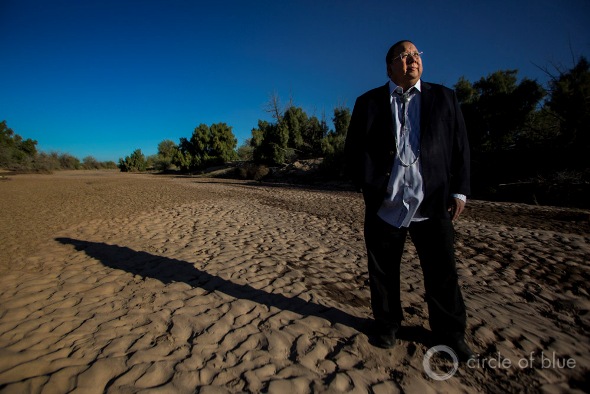

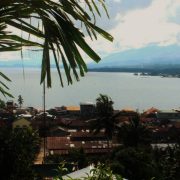





Excellent article on a major, major critical resource. That is going to become a life altering commodity. We need to stay ‘Sharp and Wise’ if we’re gonna survive this.
And, isn’t life ironic?
That the Indians who have had this land for… Forever! Are the Ones! By ‘Twist of Fate’? Father Spirit? God Almighty? Would be the Caretakers of a precious life giving element!
P.S. I would like to suggest this disturbing, and yet; absolutely brilliant book.
“Water…. Fate of Our Most Precious Resource” By Marc De Villiars
Winner of Governor General’s Award for non fiction.
Tribes are being asked to do what no senior water right holder in his or her right mind would do: trade water rights that are worth billions of dollars and will only grow in value for projects and tribal government funding that, if a cost benefit analysis were done, would be found to be worth only a fraction of the present net value of what is being given up. The federal government is once again failing in its fiduciary responsibilities to serve the tribes’ interests. They should be advising tribes to hold on to their water rights and lease some of them back to those states and irrigation interests that need water. That way the payments will go on and increase over time. Instead, the federal priority continues to be to buy off tribal governments while keeping most of the water with the mostly white irrigators who now use it, especially the heavily subsidized (and one could say “the coddled”) federal irrigators served by the US Bureau of Reclamation.
Furthermore the supposed “crisis” in California is not drought caused. California has plenty of water.; the problem is that the state allows Big Agriculture with low priority water rights to continue to expand its water use so that it can export water – in the form of alfalfa hay, almonds and pistachios – to China and other places.
Historians will look back at this tribal water settlement era as the second great rip-off of the Indigenous Peoples of what is now the USA: First they took the land and tried to “exterminate” the people; now they are taking the water, with the complicity of tribal governments, for the modern equivalent of a fistful of beads.
I challenge Circle of Blue to allow me to publish an editorial on the subject of tribal water settlements.